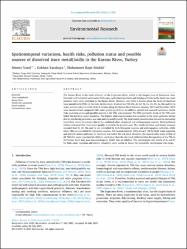| dc.contributor.author | Varol, Memet | |
| dc.contributor.author | Karakaya, Gökhan | |
| dc.contributor.author | Sünbül, Muhammet Raşit | |
| dc.date.accessioned | 2021-08-09T18:13:50Z | |
| dc.date.available | 2021-08-09T18:13:50Z | |
| dc.date.issued | 2021 | en_US |
| dc.identifier.citation | Varol, M., Karakaya, G., & Sünbül, M. R. (2021). Spatiotemporal variations, health risks, pollution status and possible sources of dissolved trace metal (loid)s in the Karasu River, Turkey. Environmental Research, 111733. | en_US |
| dc.identifier.issn | 0013-9351 | |
| dc.identifier.issn | 1096-0953 | |
| dc.identifier.uri | https://doi.org/10.1016/j.envres.2021.111733 | |
| dc.identifier.uri | https://hdl.handle.net/20.500.12899/313 | |
| dc.description.abstract | The Karasu River is the main tributary of the Euphrates River, which is the longest river in Southwest Asia. Domestic and industrial wastewater discharges, agricultural practices and mining activities in the basin can cause potential toxic metal pollution in the Karasu River. However, very little is known about the levels of dissolved trace metal(loid)s (TMs) in the river. In this study, levels of ten TMs (Fe, Al, Cd, Ni, Cu, Zn, Pb, As, Mn and Cr) in water samples taken monthly from 8 stations along the Karasu River between January 2019 and December 2019 were measured and compared with water quality guidelines. In addition, spatial and seasonal variations, health risks, pollution status and possible sources of the TMs were assessed. The 90th percentile levels of the TMs were below the drinking water standards. The highest total concentration was recorded at the most upstream station due to weathering processes, and rain and snowmelt runoff. The total metal concentration showed an increasing trend from winter to summer due to the combined effect of natural and anthropogenic sources. Metal pollution indices indicated that river water quality is suitable for potable uses. The results of factor and cluster analyses revealed that Ni, Fe, Mn and Cr are controlled by both lithogenic sources and anthropogenic activities, while other TMs are controlled by lithogenic sources. The hazard quotient (HQ) of each TM for both water ingestion and dermal contact pathways for residents was below the risk level. However, the hazard index (sum of HQs of all TMs) for water ingestion for children was higher than the risk level, indicated that the ingestion of ten TMs in the Karasu River may pose non-carcinogenic health risks to children. The carcinogenic risk results of As and Cr for both water ingestion and dermal absorption were within or below the acceptable carcinogenic risk range. | en_US |
| dc.language.iso | eng | en_US |
| dc.publisher | Elsevier | en_US |
| dc.relation.isversionof | 10.1016/j.envres.2021.111733 | en_US |
| dc.rights | info:eu-repo/semantics/closedAccess | en_US |
| dc.subject | Trace metal(loid)s | en_US |
| dc.subject | Karasu River | en_US |
| dc.subject | Health risk assessment | en_US |
| dc.subject | Factor analysis | en_US |
| dc.subject | Contamination status | en_US |
| dc.title | Spatiotemporal variations, health risks, pollution status and possible sources of dissolved trace metal(loid)s in the Karasu River, Turkey | en_US |
| dc.type | article | en_US |
| dc.authorid | 0000-0001-6475-0570 | en_US |
| dc.department | MTÖ Üniversitesi, Doğanşehir Vahap Küçük Meslek Yüksekokulu, Su Ürünleri Bölümü | en_US |
| dc.contributor.institutionauthor | Varol, Memet | |
| dc.identifier.volume | 202 | en_US |
| dc.identifier.startpage | 1 | en_US |
| dc.identifier.endpage | 9 | en_US |
| dc.relation.journal | Environmental Research | en_US |
| dc.relation.publicationcategory | Makale - Uluslararası Hakemli Dergi - Kurum Öğretim Elemanı | en_US |


















